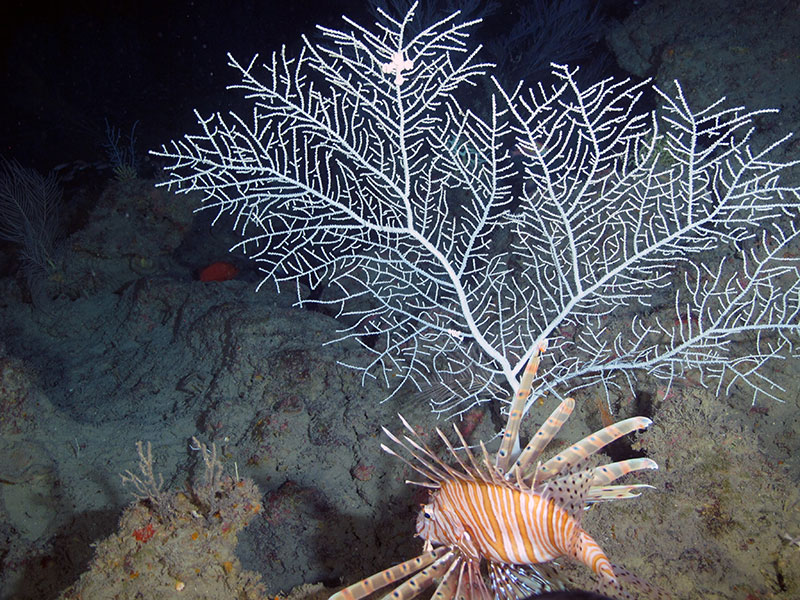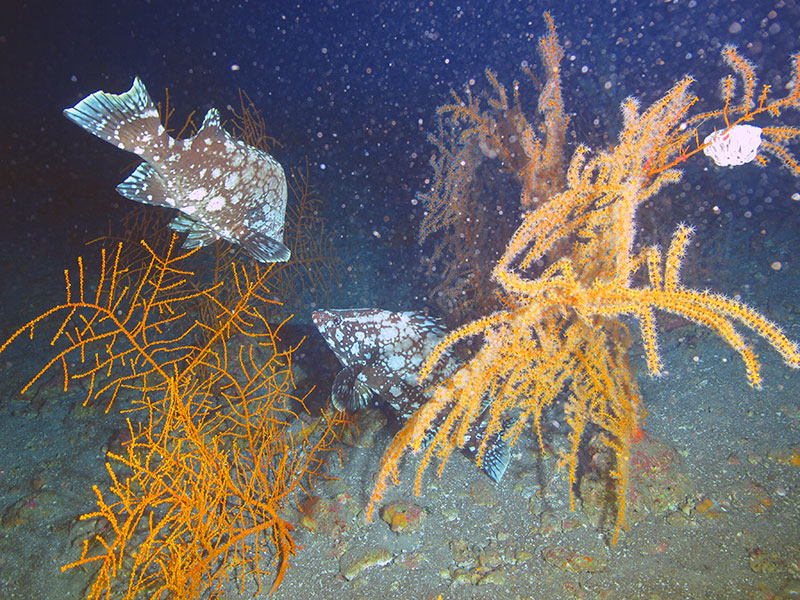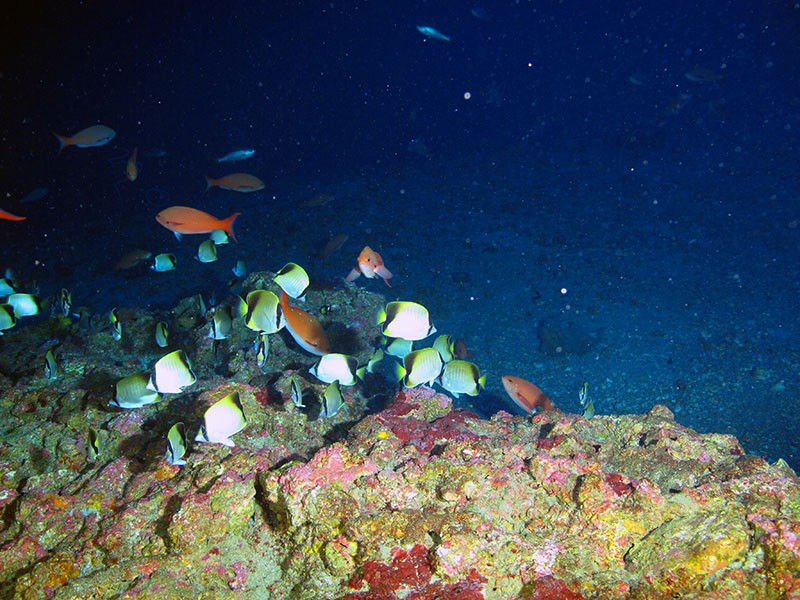
By Andrea Quattrini, Harvey Mudd College
Santiago Herrera, Lehigh University

Invasive lionfish amid a Hypnogorgia octocoral garden, 83 meters (272 feet) deep at Elvers Bank. Image courtesy of Santiago Herrera and Flower Garden Banks National Marine Sanctuary/University of North Carolina Wilmington’s Undersea Vehicles Program. Download larger version (jpg, 6.6 MB).
Coral reefs are the most diverse and valuable marine ecosystems across the globe, yet the health of many coral ecosystems is declining due to numerous human stressors. Corals are disappearing at alarming rates due to rising ocean temperatures and more localized events such as oil spills and pollution. As such, there is an urgent need to make decisions that will lead to effective management and conservation of corals and the inhabitants that they support.
In the northwestern Gulf of Mexico, the Flower Garden Banks National Marine Sanctuary has proposed to expand the boundaries of their currently protected areas to encompass additional coral habitats in mesophotic depths (~30–150 meters or 100–492 feet). Our project aims to better understand the processes that shape connectivity of corals and associated organisms throughout these areas of the northwestern Gulf of Mexico, with an overarching goal of helping to guide management decisions. In particular, we are examining population and ecosystem connectivity between shallow and mesophotic coral habitats (vertical connectivity) and among coral habitats in mesophotic depths (horizontal connectivity).
Connectivity is defined as the rate and exchange of individuals among geographically separated locales. The degree to which locales are connected can offer insight into the resiliency of those populations to perturbations, such as oil spills. For example, a population in a particular location might be relatively resilient if it receives individuals from other locations, whereas a relatively isolated population might never recover from a disturbance.

Marbled grouper, Dermatoplepis inermis, among coral communities at 98 meters (322 feet) deep at Elvers Bank. Image courtesy of Santiago Herrera and Flower Garden Banks National Marine Sanctuary/University of North Carolina Wilmington’s Undersea Vehicles Program. Download larger version (jpg, 8.1 MB).
For corals, which are sessile (or attached to the seafloor) as adults, dispersal between locations only occurs during the larval stage. Because larval dispersal can be really challenging to track in the marine environment, we are coupling physical oceanographic models with genetics to determine whether certain locations readily exchange individuals and the directionality of that exchange.
For mobile organisms such as fishes, not only does the larval dispersal stage connect geographically separated areas, but movement by adults among locations can link populations in different areas. To gain a more holistic understanding of connectivity—from populations to ecosystems—we are integrating genomics, stable isotope analyses, elemental microchemistry, habitat suitability modeling, autonomous reef monitoring systems (or ARMs), and larval dispersal models. Integrating these techniques can help to refine the accuracy of population origin assignments and migration pathways.
With predictions that global ocean change will continue to impact corals occupying shallow waters, efforts to determine whether mesophotic reefs can serve as refugia for shallow-water reefs has become particularly relevant. Coral ecosystems residing at mesophotic depths (~30–150 meters or 100–492 feet) might be less susceptible to ocean change when compared to shallow-water coral reefs. Thus, mesophotic reefs may re-seed degraded shallow-water reefs. Recent work has cast doubt on this possibility because species composition often differs across depth. However, for those species that do occur across broad depth ranges, we need to determine whether they can help shallow reefs recover, as re-seeding potential is not universal among species due to both species-specific traits (e.g., behavior and reproductive mode) and environmental factors (e.g., currents and habitat availability).

Reef fish at Elvers Bank at 83 meters deep (272 feet). Image courtesy of Santiago Herrera and Flower Garden Banks National Marine Sanctuary/University of North Carolina Wilmington’s Undersea Vehicles Program. Download larger version (jpg, 7.5 MB).
Mesophotic coral ecosystems deserve their own attention, regardless of whether they constitute a safe haven for shallow-water organisms. They too are threatened by numerous stressors. Because of the technical challenges with surveying mesophotic depths (i.e., deeper than conventional SCUBA diving), mesophotic coral ecosystems remain poorly understood across the world, including in the northwestern Gulf of Mexico. Furthermore, we have limited understanding about the degree of connectivity among mesophotic coral ecosystems. By increasing knowledge of the rates and direction of larval exchange among mesophotic reefs, we hope to guide conservation efforts to protect these unique ecosystems from future disturbances.